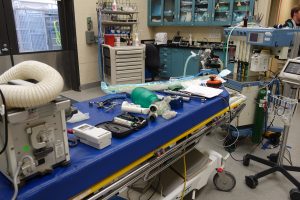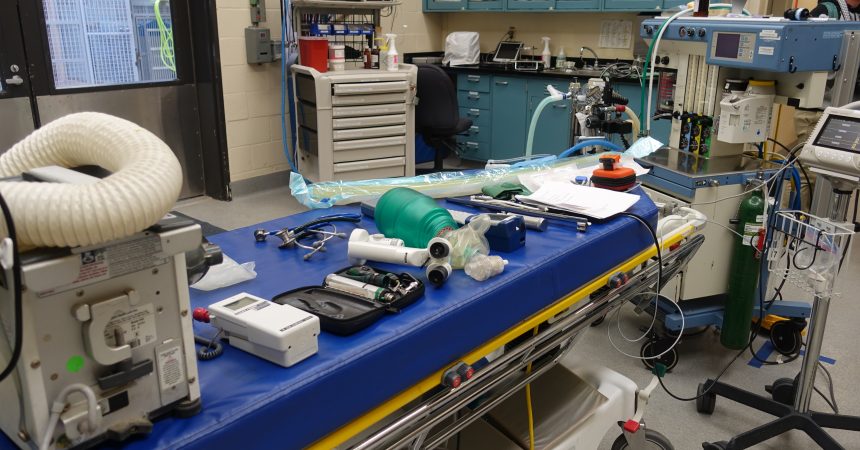Zoo InternQuest is a seven-week career exploration program for San Diego County high school juniors and seniors. Students have the unique opportunity to meet professionals working for the San Diego Zoo, Safari Park, and Institute for Conservation Research, learn about their jobs, and then blog about their experience online. Follow their adventures here on the Zoo’s website!
 On February 14th, we met Matt Marinkovich, a second-year Resident at the San Diego Zoo. As a veterinarian, Dr. Marinkovich performs many check-ups and medical procedures on a variety of animals at the Zoo. A residency is similar to something that all doctors take before they are ready to practice on their own. This three-year residency program is a requirement that all veterinarians must take in order to work with exotic animals. This program will give Dr. Marinkovich the necessary knowledge and wisdom for when he becomes a zoo veterinarian practicing on his own. Throughout our time with Dr. Marinkovich, he took us through a general protocol of what he would do if an animal became sick at the Zoo.
On February 14th, we met Matt Marinkovich, a second-year Resident at the San Diego Zoo. As a veterinarian, Dr. Marinkovich performs many check-ups and medical procedures on a variety of animals at the Zoo. A residency is similar to something that all doctors take before they are ready to practice on their own. This three-year residency program is a requirement that all veterinarians must take in order to work with exotic animals. This program will give Dr. Marinkovich the necessary knowledge and wisdom for when he becomes a zoo veterinarian practicing on his own. Throughout our time with Dr. Marinkovich, he took us through a general protocol of what he would do if an animal became sick at the Zoo.
First, Dr. Marinkovich took us to a room that had an abundance of books with large windows looking down into a surgical room. It was like a mini library! In addition to housing a wealth of information, this room acts as the hospital’s conference room. First, we were then given a small packet that described a real life case starring Matthew the ring tailed lemur. After we were introduced to Matthew the lemur, Dr. Marinkovich asked us the kinds of questions he would be asking the keepers. These questions give Dr. Marinkovich a better idea of Matthew’s normal daily routines and behaviors, and whether or not he has been acting abnormally. Even more so, we learned that a majority of the questions were very similar to the ones we’ve heard from our personal veterinarians. More specifically, these questions included: how much is he/she eating? Bowel movement? Is there discharge? Changes in personality? After we asked these questions, Dr. Marinkovich showed us a picture of what Matthew looked like when he was sick. After we all got a chance to see the photo, we were asked if we noticed anything different, and if we could conclude anything from the photo. In the photo, we saw Matthew sprawled across a log looking like he was in discomfort. After we made this distinction, Dr. Marinkovich told us that he immediately brought him to the hospital for a more thorough exam.
Once we had a better understanding of Matthew’s symptoms, Dr. Marinkovich took us to another room where they can perform surgery if needed. The room was about the size of your average classroom, and the exam table was about the size of a full size bed. After we were more familiar with the room and the tools, we learned that Matthew was transported to the hospital via a crate. He informed us that this type of crate is called a squeeze crate. At the Zoo, all the animals are trained to walk into the crate voluntarily. Once the animal is in the crate, a person then uses a handle located in the back and gradually moves it forward. This gives the veterinarian the opportunity to make the crate as big or as small as needed to safely administer anesthesia. If the animal is not trained to step into a crate, an alternative way to administer anesthesia is through a traditional tranquilizer dart. Dr. Marinkovich then told us that once the animal is asleep, then the next part of the procedure can take place: the actual exam.
Let’s think about our own check ups, doctors examine our hearts, reflexes, blood, ears, eyes, weight, etc. Dr. Marinkovich was able to show us that there really is not any huge differences between human and animal exams. The only thing that separates our exam versus an animal exam is that veterinarians have to continuously monitor the amount anesthesia, respiratory patterns, and blood pressure. Otherwise, the exam itself is very similar, and they even use the same medical instruments!
After learning the exam process, we then looked at the last part of the scenario: treatment. Just like humans, they receive medicine and antibiotics. However, most of the time, these animals are also monitored to make sure that they are getting better.
Throughout our day, we were able to follow Dr. Marinkovich around the hospital and learn all about the vital roles he plays at the Zoo. In the end, we found that being a veterinarian requires extensive schooling and involves long days with a lot of work. However, seeing the impacts that he made on these animals, this type of work seems well worth it.
Lauren, Real World Team
Week Three, Winter Session 2018


